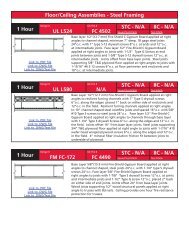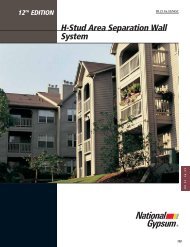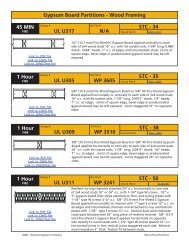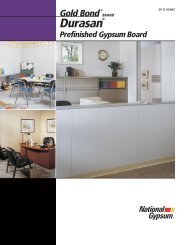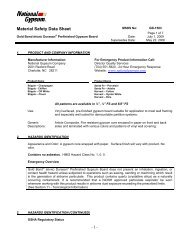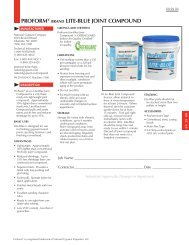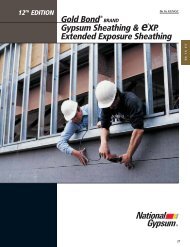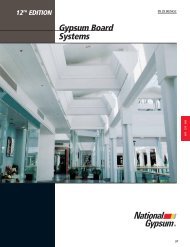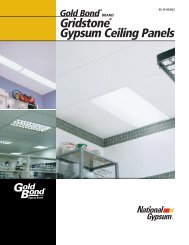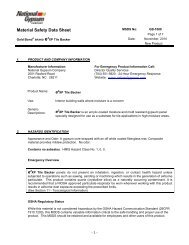National Gypsum Construction Guide - 12th Edition
National Gypsum Construction Guide - 12th Edition
National Gypsum Construction Guide - 12th Edition
You also want an ePaper? Increase the reach of your titles
YUMPU automatically turns print PDFs into web optimized ePapers that Google loves.
UNI-KAL OR X-KALIBUR<br />
APPLICATION OVER<br />
KAL-KORE<br />
1. Tightly scratch material into<br />
previously treated joints<br />
and cornerbeads, then<br />
immediately scratch-in<br />
tightly over the wall and/or<br />
ceiling area.<br />
2. Double back over the area<br />
just troweled with material<br />
from the same batch<br />
bringing total thickness up<br />
to 3/32" minimum.<br />
3. Begin finish troweling at<br />
time of initial set, using<br />
water sparingly. Final<br />
troweling must be<br />
accomplished before<br />
complete set takes place, as<br />
evidenced by darkening of<br />
the surface.<br />
Note: Uni-Kal or X-KALibur<br />
may be applied to produce<br />
a textured finish.<br />
A. When Uni-Kal or<br />
X-KALibur is mixed, add<br />
up to but not exceeding<br />
50 lbs. of silica sand,<br />
texturing grade, per<br />
50 lb. bag of plaster.<br />
B. The sanded Uni-Kal or<br />
X-KALibur mix should<br />
be scratched-in tightly<br />
over the plastering base.<br />
Immediately double<br />
back over the area just<br />
troweled with material<br />
from the same batch.<br />
C. When plaster is well<br />
taken up, float to the<br />
desired texture finish.<br />
VENEER PLASTERS DIRECT<br />
TO BOND-COATED<br />
MONOLITHIC CONCRETE<br />
DESCRIPTION<br />
The Kal-Kote System,<br />
consisting of a basecoat<br />
plaster and a finish coat<br />
plaster, Uni-Kal or<br />
X-KALibur may be applied<br />
directly to monolithic<br />
concrete treated with a<br />
bonding agent.<br />
LIMITATIONS<br />
1. Surface to be plastered shall<br />
be treated with a bonding<br />
agent applied according to<br />
manufacturer’s directions.<br />
The performance of this<br />
system is the sole<br />
responsibility of the<br />
bonding agent<br />
manufacturer.<br />
2. Concrete should be aged<br />
at least one month prior to<br />
plastering.<br />
3. Kal-Kote Smooth or<br />
Texture Finishes are not<br />
designed for direct<br />
application to concrete,<br />
but must first have Kal-<br />
Kote Base Plaster applied<br />
to fill and level surface.<br />
4. Do not apply system to the<br />
interior side of exterior<br />
walls below grade. To use<br />
above grade these walls<br />
shall be kept dry and shall<br />
have been properly<br />
waterproofed on the<br />
exterior side to prevent<br />
water penetration.<br />
52 NATIONAL GYPSUM VENEER PLASTER SYSTEMS<br />
APPLICATION PROCEDURES<br />
Note: Application shall<br />
conform to ASTM C 843.<br />
Kal-Kote Base Application<br />
Over Bonding Agent<br />
1. First straighten any major<br />
surface irregularities, such<br />
as holes, ridges, wavy<br />
sections, etc. Scratch<br />
plaster in tightly by trowel<br />
and fill out to any adjacent<br />
level area.<br />
2. After the straightening<br />
material has set, trowel in a<br />
tight scratch coat over the<br />
entire area to be plastered;<br />
then immediately double<br />
back with material from the<br />
same batch to minimum<br />
thickness of 1/16" or as<br />
required to achieve a level<br />
surface. Use a rod or<br />
feather edge if needed.<br />
3. When plaster has “taken<br />
up,” eliminate excessive<br />
trowel marks and fill all<br />
surface voids and<br />
imperfections to obtain a<br />
reasonably uniform surface.<br />
Do not trowel to a slick<br />
surface. Roughen the unset<br />
basecoat plaster surface<br />
with a serrated darby or<br />
lightly wire rake to provide<br />
mechanical keying for the<br />
finish plaster when<br />
necessary.<br />
Smooth or Textured Finishes<br />
Apply finishes to the Kal-Kote<br />
Plaster as outlined under<br />
the regular Kal-Kote System<br />
as described on page 49.<br />
Uni-Kal or X-KALibur<br />
Application Over Bonding<br />
Agent<br />
1. First straighten any major<br />
surface irregularities such<br />
as holes, ridges, wavy<br />
sections, etc. Scratch<br />
plaster in tightly by trowel<br />
and fill out to any adjacent<br />
level area.<br />
2. Allow the straightening<br />
material to set.<br />
3. Tightly scratch material in<br />
over the wall and/or ceiling<br />
area. This application<br />
should be about 1/16"<br />
thick. Double back over<br />
the area just troweled with<br />
material from the same<br />
batch, bringing total<br />
thickness up to 3/32"<br />
minimum.<br />
4. Begin finish troweling at<br />
time of initial set, using<br />
water sparingly. Final<br />
troweling must be<br />
accomplished before<br />
complete set takes place, as<br />
evidenced by darkening of<br />
the surface.<br />
Veneer plaster performs well<br />
in high traffic areas such as<br />
stairways and halls.



